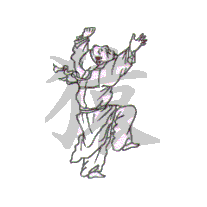
Doin ( Dao-yin )
 Ancient people learned how they can protect themselves from wild animals attack by observing and miming their lives and movements in nature.
Ancient people learned how they can protect themselves from wild animals attack by observing and miming their lives and movements in nature.
They found that human being posture, standing up on two legs, is unnatural in a view of biology. To redeeming it, they studied miming wild animals over the years and found it very useful to maintain smooth flow of ki in the body and avoid health problems.
These series of exercises organized into Doin-jutsu.
Some people say it was dances to pray for successful hunting.
The oldest record of Doin (Dao-yin) is Doin-jutsu illustrations unearthed at the excavation of Mawangdui Han tomb in chángshâ?, China in early 70's. The tomb dates from the Western Han Dynasty (206 BC-24), and the illustration shows the fact that people in 200 BC were Doin-jutsu exercises for their health, based on high level medical methods.
From Mawangdui Tomb Number 3, Chinese herbal medicine with prescriptions and medical text books that describe various diseases were found. The fact that ancient royal people had strong health awareness can be one of the greatest discoveries.
Doin Introduction to Japan
In Japan, doin was introduced in forth century along with Chinese books such as Thousand Character Litany (Chien Tzu Wen 千字文) and other ancient knowledge from China through Korean Peninsula.
Doin-jutsu, one of the three trainings Nihon Dokan provides, is originated in Doin from China. Grand Master Hayashima systematized them to enable people to learn and master in daily lives.
Nihon Dokan International
Cosmo-Sangubashi Building, 2F 4-1-5 Yoyogi,
Shibuya-ku Tokyo 151-0053 Japan
Further Information
TEL: 03(3370)7601 / FAX: 03(3370)7834


